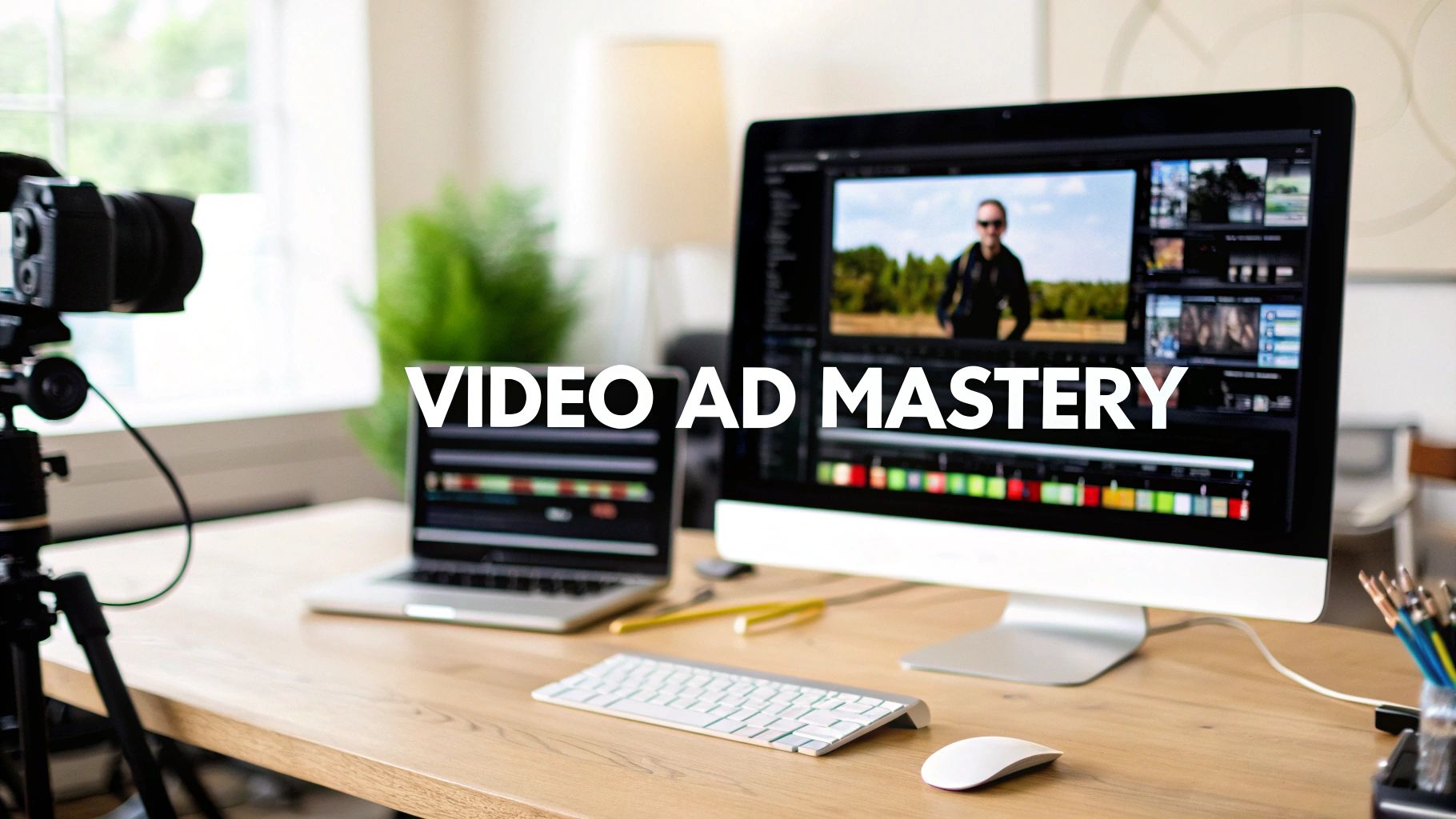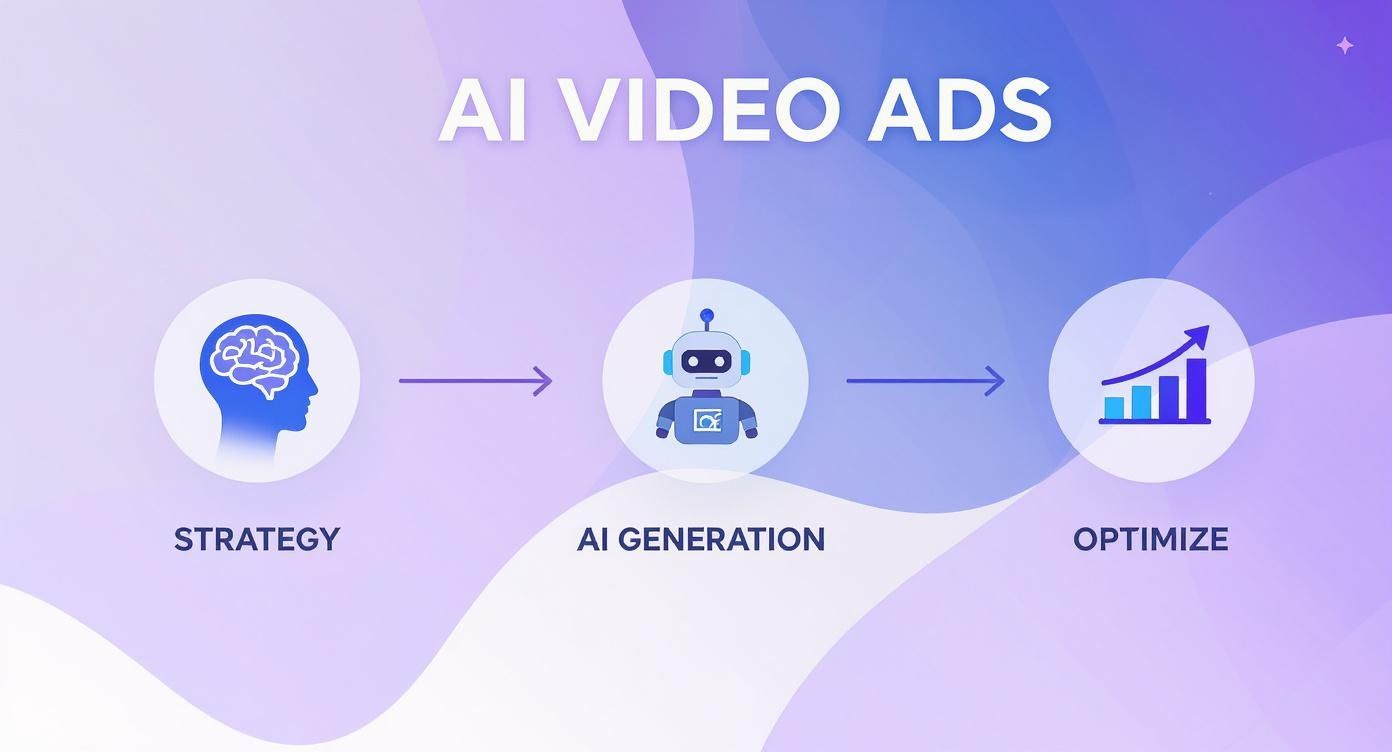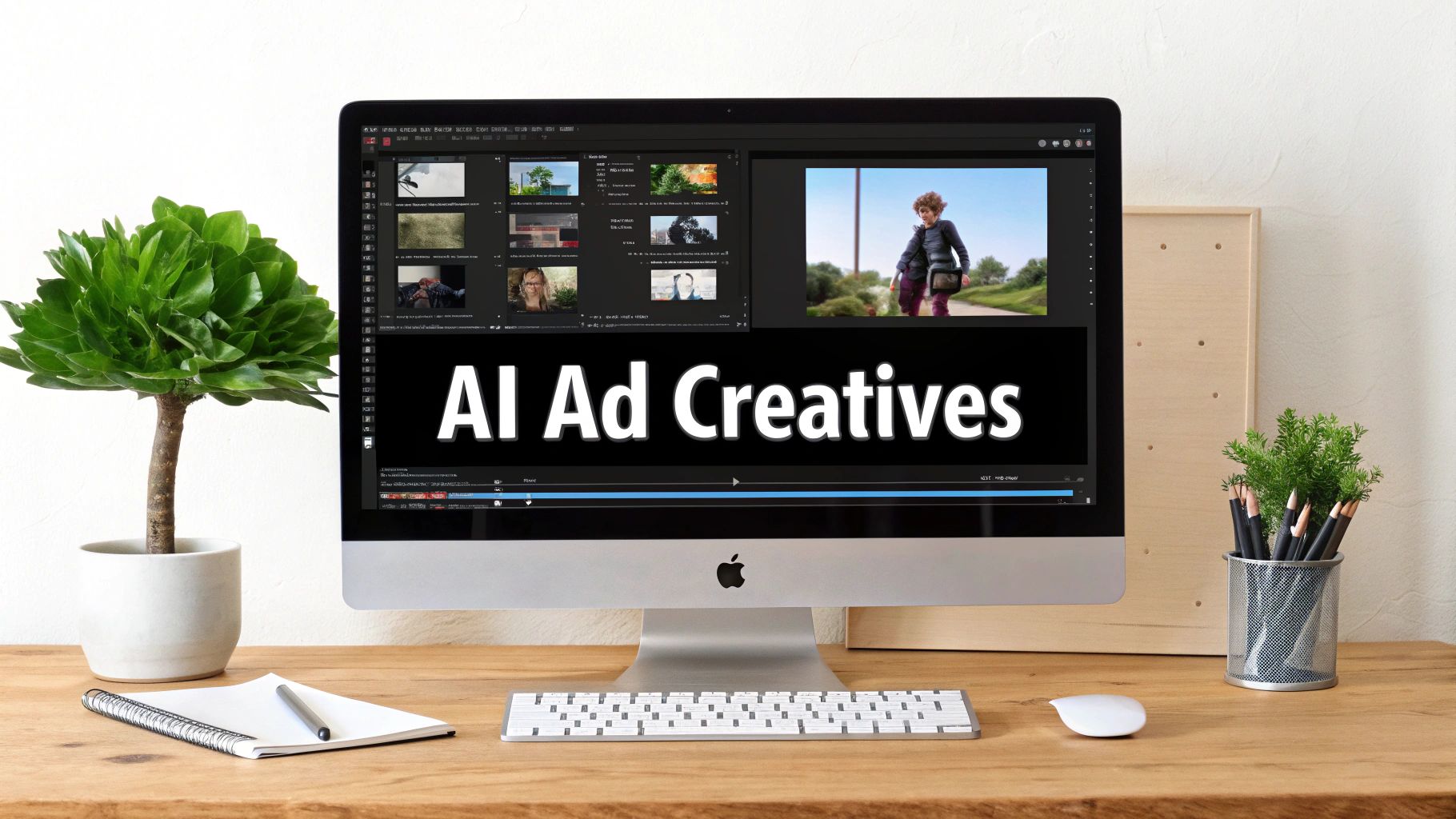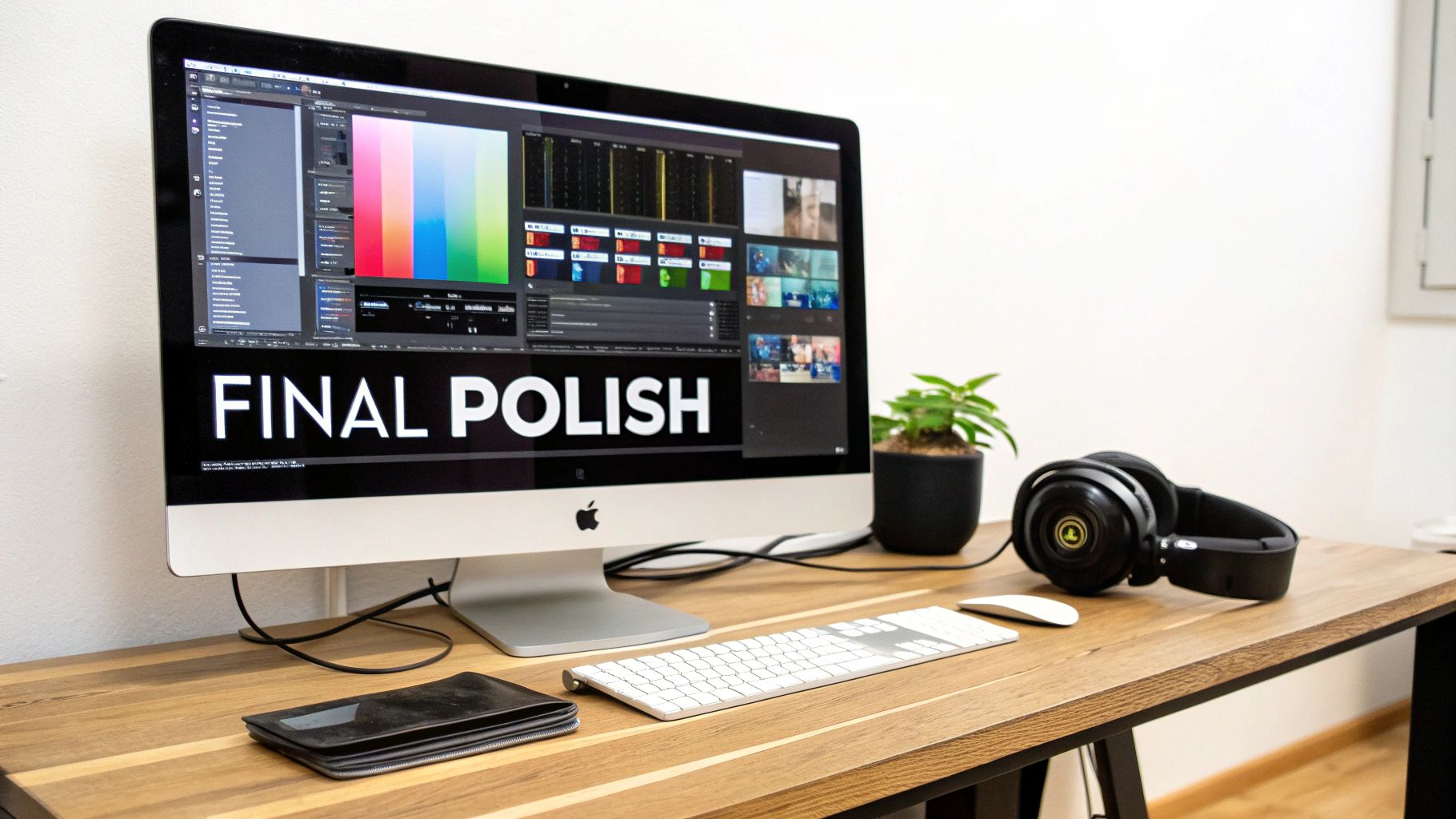
Mastering AI Video Ad Production
Discover how to master video ad production with AI. This guide provides actionable strategies for creating, optimizing, and scaling high-converting video ads.
Video ad production used to mean something completely different. It was a whole ordeal: big budgets, location scouts, long shoots, and weeks tied up in post-production. It was complex, expensive, and frankly, out of reach for most businesses.
Today, that's all changed. We’re in a new era where AI tools like ViewPrinter are leveling the playing field, making high-impact video ads faster, cheaper, and more accessible than ever. The game has shifted from chasing one perfect, high-budget ad to generating a high volume of data-driven creative that actually converts.
The New Reality of Video Ad Production
Forget the six-figure price tags and the massive production crews. The modern playbook for video ads is all about speed, scale, and performance. You don't need a Hollywood setup to make an impact anymore; what you need is a smart, agile workflow that technology can supercharge. This isn't just a trend—it's a necessary shift in a world where your audience's attention is split across a dozen different platforms at any given moment.
The numbers don't lie. The digital video ad market is exploding, with global spending projected to blow past $190 billion in 2025. Here in the U.S., that number is expected to hit $72 billion, a growth rate two to three times faster than the rest of the media ad market. To keep up with that kind of demand, you need a production model that can move at the speed of culture.
To really grasp this shift, let's compare the old way of doing things with the new, AI-driven approach.
Traditional vs AI-Powered Video Ad Production
| Production Stage | Traditional Approach | AI-Powered Approach (ViewPrinter) | Key Benefit | | :--- | :--- | :--- | :--- | | Concept & Scripting | Weeks of brainstorming, multiple revisions, and manual scriptwriting. | AI generates dozens of script variations and concepts in minutes based on a simple brief. | Speed to first draft | | Asset Gathering | Expensive shoots, licensing stock footage, and hiring actors. | Leverages a vast library of stock assets and AI-generated visuals. | Massive cost savings | | Editing & Post | Days or weeks with a professional editor for a single video. | AI assembles, edits, and adds branding to multiple video variations automatically. | Scalable production | | Testing & Iteration | A/B test one or two versions; slow feedback loop. | Generate and test hundreds of ad variations simultaneously for rapid learning. | Data-driven optimization | | Optimization | Manually analyze data and guess what to change for the next round. | AI analyzes performance data and recommends or automates the next set of creatives. | Continuous improvement |
This table makes it clear: the AI-powered workflow isn't just a slightly better version of the old one. It's a fundamentally different, more efficient, and more effective way to create ads that perform.
From Manual Labor to AI Automation
At the heart of this change are platforms like ViewPrinter. They take all the tedious, manual work—the stuff that used to eat up time and money—and replace it with smart, automated systems. This frees you up to focus on the things that actually matter: your strategy and your creative vision.
This whole process can be visualized as a simple, powerful loop.

As you can see, you start with a solid strategy, feed it into the AI generation engine, and then let continuous optimization create a feedback loop that gets smarter over time.
The new model isn't about creating just one video. It's about generating dozens of variations to test everything—different hooks, unique visuals, compelling calls to action. It’s a volume game, and the data tells you what to do next. Of course, when you're producing at this scale, staying organized is key. That’s where good digital asset management for video becomes absolutely essential.
The goal is no longer to create one perfect ad. It's to create a system that consistently produces high-performing ads by learning from real-world audience feedback.
This guide will walk you through exactly how to build that system. We’ll cover the core pillars of an effective AI-driven process, from nailing your initial concept to letting automated optimization do the heavy lifting. High-performance video advertising is finally within reach for everyone, not just the brands with the deepest pockets.
Building Your Strategic Foundation
Jumping straight into making a video ad without a plan is a recipe for wasted money and time. Think of it like trying to build a house without a blueprint. You might end up with something, but it won’t be what you wanted, and it definitely won't work. The ads that actually convert are built on a solid strategic foundation long before anyone hits "record" or "generate."
This whole pre-production phase is where you win or lose the battle for your audience's attention.
It all boils down to one simple question: What is the goal of this video?
Are you trying to drive immediate sales for a new product? Or are you just trying to get your name out there in a new market? Your objective dictates every single decision that follows. For example, a lead generation ad needs a punchy, crystal-clear call-to-action. A brand awareness video, on the other hand, might lean into storytelling to create an emotional connection.
Your campaign's objective is the north star for your entire video ad production process. Without it, you're just making noise. Decide if you want clicks, views, or conversions before you do anything else.
Know Who You're Talking To
Once you have a goal, you have to get laser-focused on who you're trying to reach. A generic message aimed at "everyone" will land with absolutely no one. This is where creating detailed audience personas becomes your secret weapon.
A persona isn't just a list of demographics. It's about getting inside your ideal customer's head.
What are their biggest headaches? What kind of humor do they actually find funny? What social media platforms do they scroll through before bed? Answering these questions helps you craft a message that feels like it was made just for them. An ad for a productivity app targeting busy entrepreneurs is going to feel completely different from one aimed at broke college students.
If you’re new to this, our guide on how to create buyer personas breaks down the entire process.
Nail Down Your Core Message
With your goal set and your audience defined, it's time to figure out your core message. This is the one big idea you want your viewer to remember. It has to be simple, memorable, and speak directly to a need your ideal customer has. Think of it as your ad's elevator pitch.
A great core message usually follows a simple formula:
- Problem: State the pain point they’re experiencing.
- Solution: Introduce your product as the clear answer.
- Benefit: Show them the positive outcome they'll get.
For a meal delivery service, it might sound like this: "Tired of cooking every night? Get healthy, delicious meals delivered and reclaim your evenings." It's clear, concise, and all about the benefit.
The Creative Brief: Your Blueprint for Success
Finally, you pull all of this thinking together into a creative brief. This document is the single source of truth for your entire project. It gets everyone on the same page—from your team to an AI like ViewPrinter—ensuring the vision stays on track.
Your brief doesn't need to be a 50-page novel. It just needs to be clear.
Here’s what to include:
- Campaign Objective: What’s the main goal? (e.g., Increase app downloads by 15%).
- Target Audience: Who are we talking to? (Pull in details from your persona).
- Core Message: What's the one thing they must remember?
- Key Talking Points: What specific features or benefits have to be in the ad?
- Tone and Style: What's the vibe? (e.g., Energetic and funny, or sophisticated and trustworthy).
- Call to Action (CTA): What do you want them to do next? (e.g., "Download Now," "Shop the Collection").
This strategic prep work might feel a bit tedious, but it saves you from endless revisions and costly mistakes later. It turns video ad creation from a guessing game into a reliable process for hitting your goals.
Generating Ad Creatives with AI
Alright, this is where your strategy gets real. It's time to turn that solid foundation into video ads that actually make an impact. With ViewPrinter, we're shifting the whole creative process from a slow, manual slog to a fast, AI-powered workflow built for one thing: conversions. We'll go from generating killer scripts to piecing together dynamic visuals, all inside one platform.
The whole point is to let the AI handle the heavy lifting. That way, you can focus on what matters—creative iteration and testing. You’re not just making a single video anymore; you’re building a system that can pump out endless variations. Frankly, this agile approach is quickly becoming the new standard.
If you look at video production trends for 2025, you'll see a massive shift toward faster, more affordable ways to create content at scale. A recent survey found that 50% of companies now handle their video production in-house, and only 13% are still relying entirely on outside agencies. This is a huge move toward accessible, high-volume video ad production, and it's all being driven by tools that make it easier for everyone.
From Prompt to Powerful Video Scripts
Everything starts with the script. A great video ad tells a story, and that story begins with the right words. ViewPrinter’s AI script generator takes your creative brief—who you're talking to, your core message, the vibe you're going for—and spins it into multiple script options built for different platforms.
Think about it. An ad for Instagram Reels has to be punchy and quick, usually under 30 seconds. A YouTube Short might give you a little more room for a story. And TikTok? That’s all about authenticity and hopping on trends. Writing unique scripts for each one is a massive time-drain.
With AI, you can get platform-specific versions in seconds. For instance, you could prompt the AI with something like: "Generate three 15-second TikTok video scripts for a new productivity app called 'FlowState.' The target audience is college students struggling with procrastination. The tone should be humorous and relatable. The CTA is 'Download for free.'"
Just like that, the AI will spit out distinct scripts, each with a different hook or angle. You’ve immediately got fresh material ready for A/B testing.
Assembling Visuals with AI Assistance
Once you've got a script you love, you need visuals to make it pop. This is another spot where traditional video ad production gets bogged down, either with pricey stock footage licenses or complicated custom shoots. ViewPrinter’s AI sidesteps all that by tapping into a massive library of high-quality stock video, images, and music, intelligently matching assets to the scenes in your script.
Here’s a quick look at how it works:
- Scene Analysis: First, the AI breaks your script down into individual scenes or moments.
- Asset Matching: Then, it dives into its library to find visuals that match the tone and topic of each scene.
- Timeline Creation: Finally, it assembles all those clips into a rough-cut video timeline, ready for you to review.
This whole automated process whips up a solid first draft in minutes, not days. From there, you can easily swap out clips, tweak the timing, and polish the sequence until it's exactly what you envisioned.
The real magic of AI in video ad production isn't just about speed. It's the ability to create unlimited visual combinations. This lets you test which imagery truly connects with your audience without having to reshoot a single frame.
This screenshot gives you a peek at the ViewPrinter interface, where you can pair those AI-generated scripts with a huge library of visuals to build your ad.

The drag-and-drop timeline is super intuitive, letting you fine-tune what the AI puts together and giving you total creative control over the final cut.
Creating Variations for A/B Testing
Putting all your budget behind a single video ad is a gamble. But launching a campaign with dozens of variations? That's a calculated strategy. The most successful advertisers don't guess what works; they test their way to the top. AI finally makes this level of testing accessible to everyone.
With your main video put together, you can use ViewPrinter to instantly spin up variations that test all the crucial elements.
Elements you should always be testing:
- The Hook (First 3 Seconds): Try out different opening lines or visuals. For our 'FlowState' app, one hook might focus on the problem ("Can't stop scrolling?"), while another focuses on the solution ("Finish your essay in half the time").
- The Call-to-Action (CTA): Experiment with your wording. Does "Download Now" pull better numbers than "Get Your Free Trial" or "Start Organizing"?
- Visual Styles: Pit a version with upbeat, energetic clips against one with a calmer, more focused vibe.
- Music and Sound: You'd be surprised how much a simple change in background music can alter the entire emotional feel of your ad.
Trying to create all these variants by hand would take forever. With AI, it's just a few clicks. This means you can launch campaigns with a whole portfolio of creatives and let real-world data tell you exactly which combination of hook, visual, and CTA brings in the best results. For a deeper dive, check out our complete guide to creating high-performing AI ad creatives.
To get the most out of these tools, it’s worth exploring how AI for content creation is changing the game in terms of speed and scale. By embracing this tech, you're moving away from a clunky, linear production model and into a dynamic, iterative one where every campaign makes the next one even smarter.
Polishing Your Video for Maximum Impact
An AI-generated video gets you 90% of the way there, which is a fantastic start. But that last 10%? That's where the magic really happens. This is where you roll up your sleeves and transform a good ad into a scroll-stopping creative that actually converts.
Inside ViewPrinter, this final polishing stage is where your brand's unique personality gets to shine. It's the difference between an ad that gets seen and one that gets remembered.

Think of it like this: AI gives you the rough draft. Now, we're going to turn it into a published masterpiece. We'll tighten up the timing, layer in some killer audio, and add the final touches that boost both brand recognition and watch time.
Nail the Pacing and Timing
You know those first few seconds are critical, but what about the rest of the video? Pacing is the rhythm of your ad—it's what keeps a viewer locked in from the hook all the way to your final call-to-action. If it's too slow, they'll get bored and scroll. Too fast, and you'll just confuse them.
ViewPrinter’s timeline editor gives you total control to get this rhythm just right. You can easily drag and drop clips to shorten a shot that lingers a bit too long or extend a moment to really let a key message sink in. The goal is a dynamic flow that feels completely natural but is secretly engineered to keep eyeballs glued to the screen.
Use Sound to Drive Emotion
Sound is the unsung hero of a great video ad. Seriously. The right background music or a well-placed sound effect can completely shift the emotional tone of your entire creative. An upbeat, energetic track can make a product feel exciting and fresh, while a more subtle, ambient score can build a sense of trust and sophistication.
You don't need to be a sound engineer, either. ViewPrinter has a built-in library of royalty-free music and sound effects, so you can find the perfect audio in seconds.
- Find Your Vibe: Filter tracks by mood, genre, or tempo to quickly find audio that matches your brand’s voice.
- Add Some Punch: Use subtle "whoosh" or "click" sounds (SFX) to emphasize on-screen text or transitions. It makes the ad feel much more dynamic and professional.
- Get the Mix Right: Easily adjust the volume levels to make sure your music supports the voiceover, not overpowers it.
Never, ever underestimate audio. It's a direct line to your audience's emotions and can make your ad feel 10x more polished.
Captions Are Non-Negotiable
Let's be clear: adding captions to your videos isn't just a "nice-to-have" anymore. It's essential. A huge chunk of people on social media watch videos with the sound off. If you don't have captions, your message is completely lost on them.
Viewers are so much more likely to watch a video all the way through when captions are available. It makes your content accessible and guarantees your message hits home, sound on or off.
ViewPrinter’s AI can auto-generate captions directly from your script, which saves you the mind-numbing task of transcribing and timing them by hand. From there, you can customize the font, color, and style to match your brand's look perfectly. For creators who want to explore even more creative tools, checking out some of the best video editing software for social media can really complement your workflow.
Add Those Final Pro Touches
A few small, final adjustments are what separate an ad that looks like it came from a template from one that looks like a custom-branded masterpiece. These details signal quality and help your ad stand out in a ridiculously crowded feed.
- Color Correction: Use the simple sliders to tweak brightness, contrast, and saturation. A quick color grade can make your footage pop and create a consistent look across all your clips.
- Brand Assets: Add your logo as a watermark in the corner. It's a simple, non-intrusive way to build brand recall.
- Branded End Screens: Don't just let your ad fizzle out. End with a clean, professional end card that shows your logo, website, and a final, unmissable call-to-action.
By spending just a little extra time on these polishing steps, you ensure every single video you launch is a powerful, professional asset for your brand.
Optimizing Your Ads Across Platforms
So you’ve created a polished, high-impact video ad. That’s a huge win, but it’s only half the battle. A brilliant ad is completely useless if it never reaches the right audience or if you don't learn from its performance. This is where the real work begins—distribution and relentless, data-driven optimization.
Your journey isn't over once you hit export. In fact, you're just getting started. Now you have to get your masterpiece formatted for every platform, dig into the analytics, and build a feedback loop that makes every ad you create from now on even smarter.

This final stage is what separates the campaigns that fizzle out from the ones that deliver consistent, scalable results.
Mastering Platform-Specific Formats
Each social media platform is its own world. It has its own rules, its own formats, and its own audience expectations. You can't just slap the same 16:9 widescreen video everywhere and hope for the best. To actually get results, you need to tailor your ads to fit natively into each feed.
- Meta (Instagram & Facebook): These platforms are all about vertical video now. For Reels and Stories, a 9:16 aspect ratio is an absolute must. You might get away with 4:5 in the main feed, but 9:16 is your best bet for grabbing the most screen real estate.
- TikTok: This is the undisputed king of vertical. Anything other than 9:16 is going to look out of place and scream "I'm an ad." Keep your videos short, punchy, and make sure your sound is on point—audio is a massive part of the TikTok experience.
- YouTube: While the traditional 16:9 format still reigns for long-form content, you can't ignore YouTube Shorts. It's a powerhouse channel that demands 9:16 vertical video.
Don't make the classic mistake of forcing a horizontal video into a vertical frame with big black bars. Use a tool like ViewPrinter to properly reframe and resize your ads. This one simple step makes your ad feel native and can dramatically improve how people engage with it.
The good news? ViewPrinter’s AI can automate this whole process. It quickly generates correctly formatted versions of your ad for every platform you're targeting, saving you hours of tedious re-editing.
The Rise of Streaming and OTT Advertising
And it's not just about social media anymore. A massive opportunity is blowing up in the streaming world. The over-the-top (OTT) advertising sector is going through a huge shift. Global OTT revenues are projected to jump from $169 billion in 2024 to a staggering $230 billion by 2029. A huge chunk of that growth—over 27% of total revenue—is coming from ad-supported video. This explosion is fueled by the incredible targeting capabilities that AI and data analytics bring to the table. You can dive deeper into how AI is shaping the future of streaming ads on pwc.com.
Analyzing Data to Find Your Winners
Once your ads are live, the real learning begins. Your ad platform’s dashboard is a goldmine of information, and it's your job to start digging. Don't get distracted by vanity metrics like views or impressions. Focus on the numbers that actually matter to your bottom line.
Key Metrics to Monitor:
- Click-Through Rate (CTR): What percentage of people who see your ad actually click on it? A high CTR means your creative is doing its job—grabbing attention and making people curious.
- Conversion Rate: Of those who clicked, how many actually did the thing you wanted them to do (like buy something or sign up)? This tells you if you're attracting the right kind of people.
- Cost Per Acquisition (CPA): How much are you paying to get one new customer? This is the ultimate report card for your ad’s efficiency.
- Watch Time & Hook Rate: How long are people sticking around? Pay close attention to the percentage of viewers who watch past the first three seconds. That's your hook rate, and it’s a vital sign of strong creative.
Start tracking these metrics across all the different ad variations you launched. You'll quickly see patterns emerge. Maybe the ad with the funny hook gets a great CTR, but the one that gets straight to the point has a much better conversion rate. That's your signal.
The Continuous Feedback Loop
This is the core of a modern video ad production strategy. The data you're gathering isn't just for a weekly report—it's the blueprint for your next round of ads.
Found a hook that’s crushing it? Great. Double down and create five new variations with different visuals. Is one specific call-to-action outperforming all the others? Make that your new standard.
This cycle of analyzing, iterating, and redeploying creates a continuous feedback loop. Your campaigns get smarter and more effective over time because every decision is backed by real-world performance data, not guesswork. This turns your ad spend from a simple expense into a powerful investment in growth.
Common Questions About AI Video Production
Switching to AI for video ads is a big move, and it's totally normal to have questions. This new way of working changes everything from how you budget to how you measure success. It even makes you rethink the role of human creativity.
Let's dig into some of the most common things marketers wonder about when they start playing with tools like ViewPrinter. Getting these answers straight helps you jump in with confidence and make sure your strategy is solid from the get-go.
How Much Should I Budget for AI Video Ad Production?
Right off the bat, one of the biggest changes you'll notice is the cost. Forget about the eye-watering invoices that come with a traditional video shoot. With AI platforms, you're usually looking at a predictable subscription fee instead of a project budget that seems to grow a mind of its own.
This completely flips the script on budgeting. Instead of pouring all your resources into one or two big "hero" videos each quarter, you can now set aside a smaller, consistent budget to churn out a high volume of ads for constant testing. It's not uncommon for businesses to create fantastic video ads for well under $500 a piece—a number that was unthinkable just a few years ago.
The real game-changer here is how low the barrier to entry has become. AI makes high-quality video ad production accessible to everyone, letting you run data-driven experiments at a scale that used to be reserved for massive brands. Your budget starts fueling learning and optimization, not just production.
This means you get to test more ideas, find out what doesn't work faster, and double down on the winners without betting the entire farm on a single creative concept.
What Are the Most Important Metrics for Video Ad Success?
It's tempting to get excited about high view counts, but let's be honest—vanity metrics don't pay the bills. When you're looking at the performance of your AI-generated videos, you need to laser-focus on the KPIs that actually move the needle for your business.
The metrics that truly matter fall into two camps: performance and engagement.
Performance Metrics:
- Click-Through Rate (CTR): This is your first gut check. It tells you if your hook and visuals are strong enough to make someone stop scrolling and click. A low CTR is often a sign your first three seconds are falling flat.
- Conversion Rate: This is where the rubber meets the road. How many people who clicked your ad actually did the thing you wanted them to do, like buy a product or sign up?
- Return on Ad Spend (ROAS): This is your north star. For every dollar you put in, how many are you getting back? It’s the ultimate measure of profitability.
Engagement Metrics:
- Watch Time: How long are people sticking around? A long watch time means your story is connecting and keeping them interested beyond that initial hook.
- Shares: A share is a personal endorsement. When someone shares your ad, they're vouching for it, which is a powerful signal that your message is hitting home.
Always make sure your primary metric lines up with your campaign goal. If you're building brand awareness, watch time might be your top priority. But if you're running a direct-response campaign, you live and die by your ROAS.
Can AI Really Replace Human Creativity?
This is the big one, isn't it? The short answer is a hard no. AI isn't here to take over the creative director's chair; it's here to be the most powerful assistant you've ever had.
Think of it this way: AI is incredible at the grunt work that often stifles human creativity. It can spit out dozens of script variations in seconds, sift through millions of stock clips to find the perfect one, and handle all the tedious, repetitive editing tasks that take up so much time. It frees you up to think bigger.
But the spark? The core idea, the emotional insight, the unique brand story—that all comes from you. The AI is only as good as the creative brief and prompts you give it. Your deep understanding of your audience and your market is what gets the whole process started. AI handles the scale, but the vision is, and always will be, human.
Ready to see how AI can transform your video ad production workflow? ViewPrinter provides all the tools you need to generate, polish, and optimize high-converting video ads at scale. Start creating for free today.